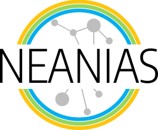Three NEANIAS atmospheric services are onboarded on the European Open Science Cloud, so they are already available to the EOSC community. This article introduces its main features and all the details on how to discover them.
![]()
A1 – Greenhouse Gases Flux Density Monitoring
The first service is A1 – Greenhouse Gases Flux Density Monitoring, developed by ATHENA RC with the support of the NEANIAS project.
ATMO-FLUD provides a set of algorithms for the calculation of flux densities of Sensible Heat, Latent Heat, Turbulent Kinetic Energy and other scalars like GHGs. The input data to the service is user provided although test data are available for trial runs. Real data should be experimentally obtained by the user bearing in mind that the fundamental methods employed in this service are the “Eddy Covariance” and the “Gradient Method”.
The service is addressed to businesses, innovators and to the research community (researchers, research projects, research groups). It can be found at https://marketplace.eosc-portal.eu/services/atmo-flud.
A video demo is also available on the NEANIAS YouTube channel, showcasing its applications and features: A1 service Video Demo.
A2 – Monitor atmospheric Perturbations and Components in Active Tectonic Regions
The second service is A2 – Monitor atmospheric Perturbations and Components in Active Tectonic Regions, developed by ATHENA RC with the support of the NEANIAS project. The service consists of Atmo-Stress and the Atmo-Seism solutions.
The Atmo-stress service, available on EOSC, reconstructs the stress trajectories in plain view for a given area, considering a specific stress component (e.g. σHmax or σHmin) as main input data. The service extends the approach presented by Lee and Angelier (1994), providing a user-friendly interface, output data compatible with Google Earth and GIS software, settings to select the interpolation method (Polynomial and Distance Weighting) and to define the processing area scale (from Global to Local), and the ability to automatically estimate suitable values for the parameters used during the interpolation.
Regarding the input data, they can be uploaded in excel or ASCII text file format, listing the following mandatory data: the azimuth value of the stress, the angular error, and the corresponding geographic coordinates.
The service is addressed to students, researchers, research communities, or research groups. It can be found at https://marketplace.eosc-portal.eu/services/atmo-stress.
For more details, it is available a video demo on the NEANIAS YouTube channel: A2 service Video Demo.
A3 – Air Quality Estimation, Monitoring and Forecasting
The third service is A3 – Air Quality Estimation, Monitoring and Forecasting, developed by UBIWHERE with the support of the NEANIAS project.
The ATMO-4CAST service delivers a novel cloud-based solution that aims to allow the prediction of air quality on an urban scale. This service is divided into three modules: Weather forecast based on the WRF model; Simulation of traffic emissions based on the QTraffic model; Local/urban scale air quality simulation based on the AUSTAL2000 model. The input data to the service is user provided although test data are available for trial runs. Real data should be experimentally obtained by the user bearing in mind the fundamental models for each module.
The service is addressed to businesses, innovators and research communities interested in smart-cities, local / urban-air-quality, or traffic-emissions regional-weather-forecast. The service is available at https://marketplace.eosc-portal.eu/services/atmo-4cast.
It is worth watching a short demonstrative video with the main features of the service on NEANIAS YouTube channel: A3 service Video Demo.
